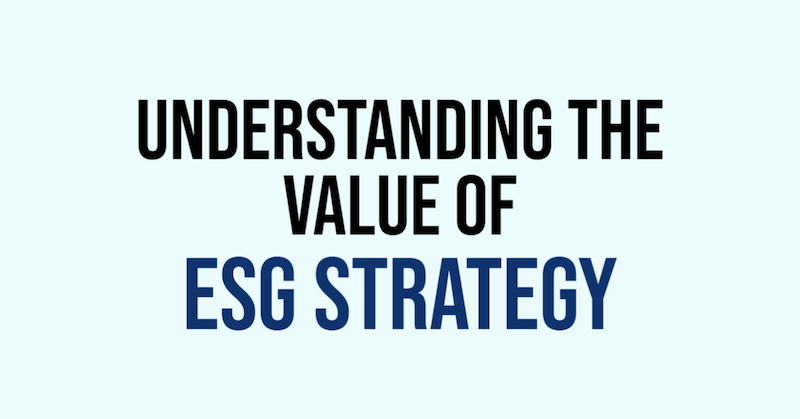It’s 2023 and the world of EHS continues to evolve radically. Move over, siloed health and safety operations - Environmental, Social and Governance (ESG) strategy is here to shake things up and help shift our perspectives about how EHS is considered within a business.
ESG is essentially rooted in the idea that an organisation’s value lies in more than just the bottom line, and that its day-to-day operations have an effect on numerous stakeholders. In a nutshell, ESG factors pertain to everything to do with business that’s not strictly numbers-related. These factors are a variety of internal and external influences that affect both the perception and positioning of your business.
ESG assets, while intangible, are becoming increasingly important for investors, creating evidence of a significant competitive edge. It’s no longer acceptable to only consider financial metrics; investors now also consider a company’s impact on the environment, its employees, and the communities it operates in.
For investors, a strong ESG strategy that compliments the internal EHS of a company is the new gold standard. For organisational leaders, this also just makes good business sense. With ESG front and centre, organisations can tap into high-growth markets, invest in long-term assets, and develop a culture that attracts the best talent.
Research clearly shows that companies with strong ESG strategy have better financial performance, and also see a lower rate of workplace accidents. Statistics such as these highlight the clear link between health and safety, and ESG, and how combining ESG strategy with health and safety practices will streamline your organisation’s performance.
The ESG criteria began as a UN initiative, encouraging businesses to consider their impact within these areas - environment, social and governance - and focus on the wider risk of their operations. 20 years later, ESG criteria have grown into a broad series of indicators that represent more than $US 23 trillion in value.
Understanding what each pillar of ESG entails is incredibly valuable for decision-making, risk management, and maximising your stakeholder engagement. Not only will a strong strategy attract more investors, but it will also help you to reduce your impact as an organisation, and improve your systems throughout.
In this blog, we explore the complexities and nuances of each pillar, and examine why ESG strategy is an indispensable part of the future of business.
Get fresh H&S insights weekly
Environmental pillar:
Would the Lorax be content with how your business is running? Environmental factors consider the extent to which a company may act as a steward of nature and be involved in the conservation of the natural world.
Specifically, environmental factors are centred around how much energy a business consumes and how much waste it produces as a result. These factors also take into account an organisation’s contribution to climate change.
Implementing sustainable practices into all the elements of business activity is another element to the environmental criteria. Sustainability is becoming a critical point of contention in the buyer decision-making process, as consumer tastes are leaning towards a willingness to pay a premium for sustainable products and services. We’ve seen this already in the egg industry, where free-range eggs are now becoming the industry standard, rather than the exception.
Some of the complexities of the environmental pillar, however, include supply chain management, resource usage, and product sustainability. Only highlighting sustainability, without considering these key factors can turn into greenwashing - where exaggerated or misleading marketing paints a company’s sustainability and environmental focus in a greater light than what it truly is.
For a truly successful environmental strategy that has a long-term vision for helping transform your industry for the better in terms of climate impact, you should consider your organisation and offering within its entire life cycle, from conception to end user. If the suppliers you partner with, for example, are not committed to similar environmental goals, you risk undermining your ESG strategy. Similar, if you’re in the product space, creating goods that are designed to last is paramount.
Once again, when it comes to EHS, the environmental pillar overlap is clear, as both functions consider the environment. From an EHS perspective, the environment is critical. In day-to-day operations, your organisation's physical environment should enhance employee health (i.e. high air quality, clean and safe working spaces) and not compromise their safety in any way. Taking a step back, long-term EHS will look like long-term investment in climate change and the organisation's impact as a whole on the environment, so that people are kept health and safe for generations to come.
Social pillar:
These factors address the relationships you have across the board - both within your organisation, as well as external stakeholders including customers, suppliers and local communities.
It’s hardly groundbreaking, but factors such as diversity and human rights are taking the front seat when it comes to business operations. Businesses that value these factors aren’t exceptions; rather, businesses that do not, are no longer viable in today’s world. And rightly so - focuses on championing workplace diversity and the provision of equitable opportunities for all, has been a long time coming.
Not only is equity key for building a better world, but businesses that focus on doing so, reap the benefits of the availability of broader skill sets, perspectives and heightened out-of-the-box thinking.
Consumer protection is another part of the social factor criteria, ensuring that consumers don’t get cheated or taken advantage of, or sold unsatisfactory goods. Other areas that social factors cover include animal welfare, data protection and privacy, labour standards and community relations.
In our recent webinar, Naomi Kemp, Director of Safe Expectations, and the Chair of AIHS, and Mike Cosman, Chair of NZISM and Partner of Cosman Parkes, discussed the implications of the social pillar of ESG. In their experience, the social pillar is often underdeveloped in organisations.
For small to medium sized enterprises - especially those without a board of directors - ensuring that finding appropriate resources for your people is key. If you encounter issues within the team, and don't have the answer yourself, Naomi recommends that you take the time to seek out qualified professionals to give your team the best possible care.
Mike adds that, finding your why, as an owner, is critical. Ensuring that you’re trying to help your people with their best interests at heart, is the right step forward and formulates a sturdy ESG strategy.
Governance:
Effective governance ensures that organisations have fortified their internal structures - including systems, processes, and protocol - in a way that ensures transparent, accurate decision-making is the modus operandi at all times.
Some of the key areas in governance to address for a comprehensive ESG strategy include both board and executive compensation transparency. Ensuring the correct compensatory balance is struck helps with a company’s performance and reputation.
Within these factors come management structure (how your hierarchy is organised), employee relations and internal culture, as well as the need to disclose executive compensation. Governance factors prompt businesses to always consider their stakeholders when undergoing important decision-making, not just the bottom line.
Organisations that undergo good governance in their ESG strategy are transparent with their reporting and therefore their stakeholders. They don’t engage in preferential treatment, or illegal activity, and their teams can thrive because of it.
ESG - isn’t it all obvious?
While many of these factors are inextricable elements of current business practice, they’re sometimes shunted to the side when it comes to cold, hard financial planning. Perhaps it comes somewhat surprisingly then, to learn that investors apply non-financial ESG factors to their analysis to identify material risks and growth opportunities.
It may seem obvious at a glance that organisations should evaluate these areas within their businesses, but now there’s also incentive to do so from an investment standpoint. There are specific areas where a focus on ESG factors directly helps create value, and neglecting these areas might be detrimental to organisational longevity.
What value-creation exists directly from these ESG factors?
1. Top-line growthBy committing to sustainability across your product or service range, you’ll attract a greater range of B2B or B2C customers and stay within government compliance regulations. Ultimately, sustainability is becoming an inherent part of how we do business.
You’ll also tap into early-stage, high-growth markets, whilst simultaneously benefitting from governmental support (think electric vehicle subsidies) that creates access to opportunities for growth. There’s an ever-increasing customer segment that is willing to pay a premium for demonstrated clean, green products. The more companies that subscribe to ‘going green’, the more this customer segment can expand.
On the flipside, not adhering to sustainability standards and regulations could do irreparable damage to your existing clientele and overall brand reputation.
2. Attract millennial investorsThe next generation of investors and workers have a far greater focus on social consciousness and global self-awareness. This generation has grown up with the climate crisis being taught in schools, and have witnessed the rise in collective focus on mental wellbeing, social welfare and the value of an enjoyable and rewarding working environment.
As a result, this younger age group, who are making their way to significant investing positions, represents a transition in societal mindset towards business that values an organisation's impact on many factors, rather than a sole focus on numbers.
3. Investment and asset optimisationWhen you invest in sustainable, long-term assets over their energy-guzzling counterparts, you’re optimising your business practice with innovative long-term thinking.
Investing in company assets with a sustainable mindset keeps energy consumption top of mind and ensures your business is looking forward. You’re more likely to choose assets that have a lower energy-consumption rate, and will last longer, which benefits your business in the long run.
4. Productivity boostEmployees working for an organisation with a strong purpose will always be more motivated than those who do not. Focusing on employee wellbeing as well, particularly with carefully thought-out company internal structure, as well as wellbeing incentives, create an environment where people can be supported, and consequently, more productive.
With a strengthened internal structure, opportunities for individual growth and a company-wide focus on minimising waste and environmental harm, you’ll benefit from a strong reputation that attracts top-level talent.
5. Long-term viabilityESG leaders in all industries have shown greater resilience during the global pandemic crisis, demonstrating a more robust, long-term performance.
Proactive and future-focused companies understand the need to communicate ESG within their business strategy and purpose and have demonstrated higher ESG performance and higher returns on their investments, lower risks, and better resilience during the crisis.
From an investor’s perspective, a focus on ESG factors helps to minimise investment risk, by weeding out unsustainable companies, with outdated practices and potentially harmful side effects of their operational activity.
Final words:
Proactively thinking about your ESG proposition is a great way to see how these factors can create value for your organisation.
With ESG comes exponential value creation, from attracting top investors, keeping your people happy and healthy, to operating with integrity - future-proofing your organisation for generations to come.




.png?width=352&name=Copy%20of%20RETAIL%20SAFETY%20(2).png)

.jpg?width=352&name=AI%20health%20and%20safety-1%20(1).jpg)

